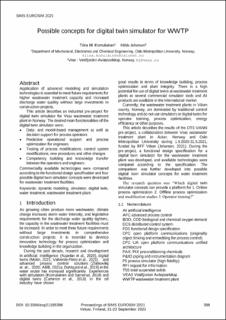| dc.contributor.author | Komulainen, Tiina | |
| dc.contributor.author | Johansen, Hilde | |
| dc.date.accessioned | 2022-10-07T10:25:30Z | |
| dc.date.available | 2022-10-07T10:25:30Z | |
| dc.date.created | 2021-12-27T11:24:08Z | |
| dc.date.issued | 2021-03-31 | |
| dc.identifier.issn | 1650-3686 | |
| dc.identifier.issn | 1650-3740 | |
| dc.identifier.uri | https://hdl.handle.net/11250/3024471 | |
| dc.description.abstract | Application of advanced modeling and simulation technologies is essential to meet future requirements for higher wastewater treatment capacity and increased discharge water quality without large investments in construction projects. This article describes an industrial pre-project for digital twin simulator for Veas wastewater treatment plant in Norway. The desired main functionalities of the digital twin simulator were: • Data- and model-based management as well as decision support for process operators • Predictive operational support and process optimization for engineers • Testing of process modifications, control system modifications, new procedures and other changes • Competency building and knowledge transfer between the operators and engineers Commercially available technologies were compared according to the functional design specification and four possible digital twin simulator concepts were developed for wastewater treatment facilities. | en_US |
| dc.description.sponsorship | RFF Viken granted funding through the pre-project number 316678. | en_US |
| dc.language.iso | eng | en_US |
| dc.publisher | Linköping University Electronic Press | en_US |
| dc.relation.ispartofseries | Linköping Electronic Conference Proceedings;No. 185 | |
| dc.rights | Navngivelse 4.0 Internasjonal | * |
| dc.rights.uri | http://creativecommons.org/licenses/by/4.0/deed.no | * |
| dc.subject | Dynamic modeling | en_US |
| dc.subject | Simulators | en_US |
| dc.subject | Digital twins | en_US |
| dc.subject | Water treatment | en_US |
| dc.subject | Wastewater treatment plants | en_US |
| dc.title | Possible concepts for digital twin simulator for WWTP | en_US |
| dc.type | Conference object | en_US |
| dc.description.version | acceptedVersion | en_US |
| dc.rights.holder | (c) 2022 Tiina Komulainen, Hilde Johansen | en_US |
| cristin.ispublished | true | |
| cristin.fulltext | postprint | |
| cristin.qualitycode | 1 | |
| dc.identifier.doi | https://doi.org/10.3384/ecp21185398 | |
| dc.identifier.cristin | 1972166 | |
| dc.source.journal | Linköping Electronic Conference Proceedings | en_US |
| dc.source.volume | 185 | en_US |
| dc.source.issue | 185 | en_US |
| dc.source.pagenumber | 398-404 | en_US |
| dc.relation.project | Regionale forskningsfond Oslofjordfondet: 316678 | en_US |
| dc.subject.nsi | VDP::Kjemisk prosessteknologi: 562 | en_US |
| dc.subject.nsi | VDP::Chemical process engineering: 562 | en_US |
| dc.subject.nsi | VDP::Kjemisk prosessteknologi: 562 | en_US |
| dc.subject.nsi | VDP::Chemical process engineering: 562 | en_US |
| dc.subject.nsi | VDP::Kjemisk prosessteknologi: 562 | en_US |
| dc.subject.nsi | VDP::Chemical process engineering: 562 | en_US |

